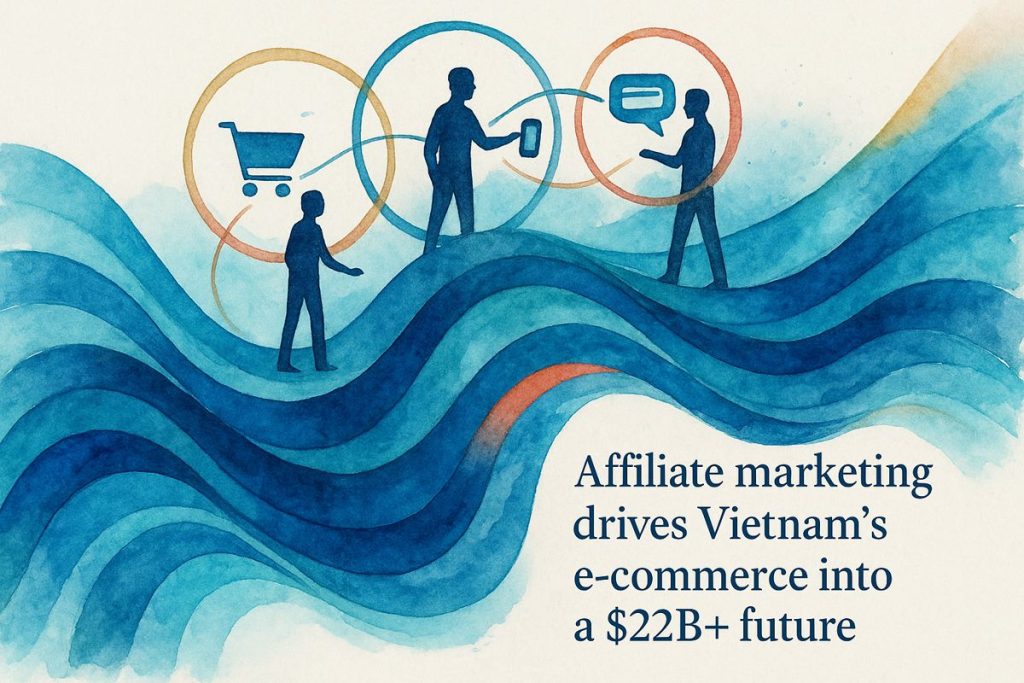Vietnam’s e-commerce market in 2025 is exploding with energy and excitement, driven by a young, tech-loving crowd and easy mobile payments. Affiliate marketing is the special ingredient, letting small businesses pay only when they make real sales, while influencers help make brands feel honest and trustworthy. Social media platforms like TikTok and Facebook have turned shopping into a lively show with live streams and viral moments. Most people shop right on their phones, blending fun, chatting, and buying all at once. The whole scene moves fast, with brands racing to keep up with ever-changing trends and digital adventures.
What is driving the rapid growth of Vietnam’s e-commerce market in 2025?
Vietnam’s e-commerce market in 2025 is booming due to a youthful, digitally savvy population, widespread mobile payments, and the rise of affiliate marketing. Key drivers include influencer-led campaigns, social commerce platforms like TikTok Shop, and cost-effective, data-driven marketing favored by SMEs.
The Electric Surge: Vietnam’s Online Bazaar Explodes
Vietnam’s e-commerce market in 2025 feels less like a steady river, more like a firework ricocheting off the walls of Southeast Asia. The headline numbers are hard to ignore—$14.7 billion in current value, with forecasts that oscillate between $22 billion and $45 billion in gross merchandise value, depending on which oracle you consult (OpenCart, Data Insights Market). That’s not just growth; that’s a cacophony of digits, the sort of chart that makes venture capitalists weak in the knees.
Why this runaway expansion? The population skews young; over half are younger than 35, and Gen Z’s symbiosis with digital life is almost uncanny. During a recent stroll through central Ho Chi Minh City, I counted more smartphones than motorbikes—a statistic I admittedly can’t verify, but the takeaway was clear: this is a culture marinated in connectivity. E-wallets chirp, notifications ping, and you can practically smell the ozone from all that digital friction. Vietnam’s zest for digital payment innovation would make even the team at Stripe raise an eyebrow in appreciation .
And yet, with all this tectonic movement, there’s a question that lingers in the air like the aroma of strong Robusta: What’s actually driving the next leap? Enter affiliate marketing—the under-sung catalyst and, dare I say, the yeast in the e-commerce dough.
Affiliate Marketing: Vietnam’s Secret Sauce
Affiliate marketing, for the uninitiated, isn’t just tossing promo codes into the digital void and hoping for clicks. No, it’s more like assembling a ragtag ensemble of digital jazz musicians—bloggers, influencers, price-comparison wizards—each riffing on their own, but all playing to the same sheet music: sales conversions (ReportLinker). The model is refreshingly mercenary: you only pay for what gets sold, not for empty promises.
One peculiarity that stands out is how SMEs have latched onto affiliate marketing like a barnacle to a ship’s hull. Why? Because, instead of burning through a stack of dong on upfront ad buys, they funnel funds only after seeing results—a trick borrowed, perhaps subconsciously, from the way Alibaba’s Taobao upended cost models in China.
But let’s not forget the human element. Vietnamese youths, a generation weaned on live-streams and avatar-driven chat, are allergic to inauthenticity. That’s where local influencers come in, their endorsements ringing true, their video testimonials as textured and intimate as the sizzle of bánh xèo on a street-side griddle. The math is elegant: affiliate marketing = trust + data + cost control.
And yet, I’ll admit—when I first trawled through Vietnam’s affiliate dashboards, the sheer hyperspectral variety of traffic sources made my head spin. Some sources were less than kosher. Lesson learned (and not without a little embarrassment): track, verify, and always, always hedge against click fraud.
Social Commerce, Mobile Mayhem, and the Whims of Virality
Vietnam’s e-commerce isn’t happening in an isolated digital universe. It’s a palimpsest, layered with social media banter, TikTok dances, and the sort of influencer microdramas that would make Fyodor Dostoevsky blink. Social commerce—buying directly via Facebook and TikTok Shop—has ballooned, expected to command a $5 billion market by the stroke of 2025 (BusinessWire).
And the real kicker? Almost 57% of Vietnamese consumers complete transactions on mobile devices (Statista). That’s not just a mobile-first society—it’s a mobile-only one, at least for many. I recall an episode at a café near Hanoi’s West Lake; a barista took my order, then seamlessly shifted his focus to a TikTok live stream, hawking soy candles with the practiced ease of a veteran auctioneer. The boundaries between commerce, community, and entertainment are blurring—a synesthetic swirl of sight, sound, transaction.
Let’s not sugarcoat it, though. The pace is dizzying. Sometimes, even the most agile brands fumble as the algorithmic winds shift. I once recommended a Facebook shop integration to a mid-tier apparel brand, only to see their traffic dissolve when a platform tweak buried their posts. Ugh—humility learned, agility required.
Influencers, Live-Streams, and the Path Forward
Live commerce is the dragon everyone’s trying to ride. Influencers orchestrate shopping festivals with the theatricality of a Cirque du Soleil act, demonstrating products, fielding rapid-fire questions, and sealing sales in real time. There’s a raw, tactile quality to it: the click of keys, the nervous laughter
